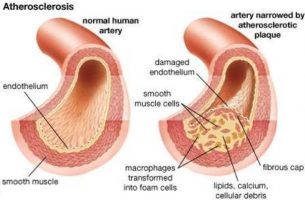- Home
- Editorial
- News
- Practice Guidelines
- Anesthesiology Guidelines
- Cancer Guidelines
- Cardiac Sciences Guidelines
- Critical Care Guidelines
- Dentistry Guidelines
- Dermatology Guidelines
- Diabetes and Endo Guidelines
- Diagnostics Guidelines
- ENT Guidelines
- Featured Practice Guidelines
- Gastroenterology Guidelines
- Geriatrics Guidelines
- Medicine Guidelines
- Nephrology Guidelines
- Neurosciences Guidelines
- Obs and Gynae Guidelines
- Ophthalmology Guidelines
- Orthopaedics Guidelines
- Paediatrics Guidelines
- Psychiatry Guidelines
- Pulmonology Guidelines
- Radiology Guidelines
- Surgery Guidelines
- Urology Guidelines
Medical Treatment of Familial Hypercholesterolemia

Familial Hypercholesterolemia(FH) is an autosomal dominant genetic disorder thereby meaning that each first-degree relative has a 50% of inheriting FH. Therefore treating this form of hypercholesterolemia takes a more aggressive approach than that used for lifestyle-induced high cholesterol. FH patients usually need medications that lower cholesterol levels in addition to a diet low in saturated fat, regular exercise and eliminating smoking and exposure to secondhand smoke. FH is most often treated by a combination of medicines, each of which serves a different function and complements the others.
The treatment principles are as hereunder-
- Statins are a commonly recognized category of medicines that inhibit the production of cholesterol in the liver. They are often prescribed in combination with other lipid-lowering drugs such as bile acid sequestrants, a cholesterol absorber, fibrates, niacin, phytosterols, and fish oils/omega 3 fatty acids.
- New drugs called PCSK9 inhibitors have been approved by the FDA.
- Two new treatments for HoFH have recently been approved by the FDA: mipomersen and lomitapide.
- Some individuals who don't show requisite improvement with usual treatment may need a treatment called LDL Apheresis, during which blood or plasma is taken out of the body, the LDL cholesterol is filtered out, and the filtered blood or plasma is returned to the body. This treatment is done on a regular basis – often every two weeks – at an LDL Apheresis center.
According to guidelines the medical treatment has to be instituted in scientific manner.
- Statin treatment should aim for at least a 50% reduction in LDL-C concentration from the baseline measurement.
- The dose of statin should be increased to the maximum licensed or tolerated dose to achieve a recommended reduction in LDL-C concentration of greater than 50% from baseline (that is, LDL-C concentration before treatment)
- Ezetimibe monotherapy is recommended as an option for treating primary heterozygous-familial hypercholesterolaemia in adults in whom initial statin therapy is contraindicated
- Ezetimibe monotherapy is also recommended as an option for treating primary heterozygous-familial hypercholesterolaemia in adults who cannot tolerate statin therapy
- Ezetimibe, co-administered with initial statin therapy, is recommended as an option for treating primary (heterozygous-familial) hypercholesterolaemia in adults who have started statin therapy when:
- serum total or low-density lipoprotein (LDL) cholesterol concentration is not appropriately controlled either after appropriate dose titration of initial statin therapy or because dose titration is limited by intolerance to the initial statin therapy and
- a change from initial statin therapy to an alternative statin is being considered
- In people whose LDL-C levels are not adequately controlled despite maximal tolerated lipid-lowering therapy, Alirocumab is recommended as an option for treating primary hypercholesterolaemia or mixed dyslipidaemia, only if:
- Low‑density lipoprotein concentrations are persistently above the thresholds specified in the table despite maximal tolerated lipid‑lowering therapy
Low‑density lipoprotein cholesterol concentrations above which alirocumab is recommended
Without CVD With CVD High risk of CVD Very high risk of CVD Primary non‑familial hypercholesterolaemia or mixed dyslipidaemia Not recommended at any LDL‑C concentration Recommended only if the LDL‑C concentration is persistently above 4.0 mmol/l Recommended only if LDL‑C concentration is persistently above 3.5 mmol/l Primary heterozygous‑familial hypercholesterolaemia Recommended only if LDL‑C concentration is persistently above 5.0 mmol/l Recommended only if the LDL‑C concentration is persistently above 3.5 mmol/l
Adults with FH with intolerance or contraindications to statins or ezetimibe should be offered a referral to a specialist with expertise in FH for consideration for treatment with either a bile acid sequestrant (resin) or a fibrate to reduce their LDL-C concentration.The decision to offer treatment with a bile acid sequestrant (resin) or a fibrate in addition to initial statin therapy should be taken by a specialist with expertise in FHHealthcare professionals should exercise caution when adding a fibrate to a statin because of the risk of muscle-related side effects (including rhabdomyolysis). Gemfibrozil and statins should not be used together.

Disclaimer: This site is primarily intended for healthcare professionals. Any content/information on this website does not replace the advice of medical and/or health professionals and should not be construed as medical/diagnostic advice/endorsement or prescription. Use of this site is subject to our terms of use, privacy policy, advertisement policy. © 2020 Minerva Medical Treatment Pvt Ltd